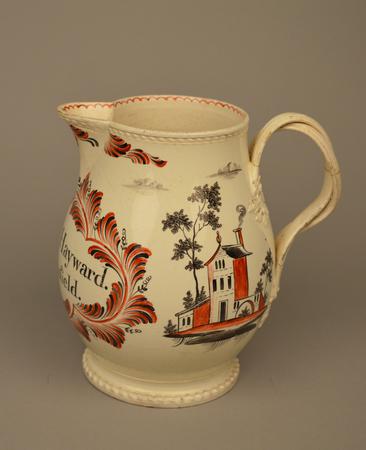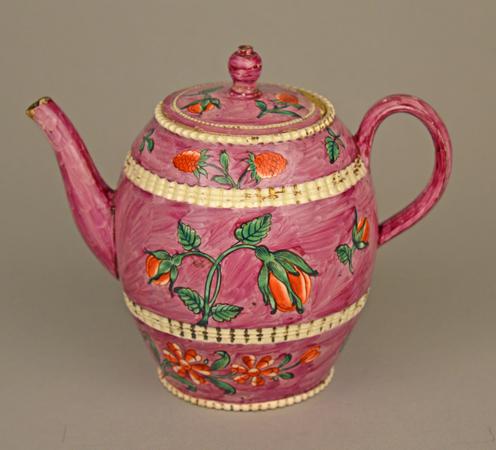2023-4-13
尽管德国的梅森瓷器一枝独秀,可是世界上真正喜欢瓷器也对瓷器作出重大贡献的国家应该是英国。英国人爱喝,喝茶喝酒喝奶喝巧克力喝咖啡喝威士忌喝伏特加。喝的东西是液体都得用瓷器来盛啊,需求量大,又是日不落帝国,于是就促进了世界上瓷器的传播和发展。梅森的瓷器人高马大曲高和寡,主要是供应西方世界和上流社会,英国的瓷器则是遍地开花面向普罗大众和全世界的穷人。她不但发明了骨瓷,在奶黄釉(Creamware)和珍珠白(Pearlware)方面也成果不俗,留下很多绝世的精品,现在就说说曾经在历史上昙花一现(1770-1881)而产品却惊世骇俗大名鼎鼎余音绕梁的利兹(Leeds)奶黄釉吧。
Antique Leeds Pottery plain undecorated creamware teapot late 18th century. The creamware glaze is of high quality typical of Leeds Pottery. The tea-pot cover has a flower head finial and the strap handles are beautifully modeled and applied. A classic piece from one of the major manufacturers of creamware pottery in the late 18th century in England. Designs from this early period of pottery manufacture are classic in their elegance, many shapes produced were based on sterling silver pieces. Very little creamware was painted under the glaze, and thus it is rather rare in archaeological collections.
Leeds Pottery was founded in 1770 by Richard Humble and the
brothers John and Joshua Green. The Greens’ cousin Savile Green
and an entrepreneur William Hartley joined soon after. It was as
Humble, Hartley, Greens & Company that they were to become
known for decorative tableware. Their best years for art pottery
started around 1780 and then spanned barely half a century. The
ongoing series of mergers, closures, and bankruptcies continued
until the company closed for good in 1881. By that time they had
become focused on producing less decorative utilitarian ware.
They were by far the largest of the thirty-five potteries in Leeds,
with only five of those recorded as having produced similar wares.
The bulk of Leeds Pottery’s production was and remained
creamware, with a translucent lead glaze and hardly ever
decorated. But they also made highly decorative examples of what
might today be called folk art, not the finest bone china, but honest
and expressive everyday pieces of art pottery. Like French faience,
it was the poor man’s porcelain of the time. And, like its French
counterpart, it is highly prized today.
This child’s creamware pottery drum form teapot with painted flowers and cherries stands a mere 2.5 inches high and is just over 3.5 inches from handle to spout. It was made in England during the 4th quarter of the 18th century. At some point in its early history, I imagine a child dropped the teapot during play teatime and the original handle broke off. Luckily for the child and eventually for me, a tinsmith made a metal replacement handle and the imaginary tea was able to flow again.

|
| 
|
利兹奶黄釉奶杯 - creamware; oviform shape with projecting lip and ribbed double intertwined loop handle, repaired, with flower and leaf terminals; overpainted in enamel colors of red and black showing two similar houses with smoking chimneys and in front (1775). |
|
利兹奶黄釉茶壶; lead-glazed creamware; barrel-shaped; painted with growing strawberry plants in green and red, on a pink ground broken by two crimped horizontal bands which have been gilt; similar bands on edges (1785).
这两件是大英博物馆的藏品。看起来圈足或瓶盖上有一圈鼓钉纹的,基本上都是利兹奶黄釉。 |
维多利亚博物馆收藏的利兹奶黄釉。

叁彩或多彩颜色的出现,在1830年以后才变得比较普遍。
这把茶壶。很久以前买到的,就是利兹的奶黄釉,1795-1815年期间的作品,妥妥的中国风,崇尚小即美,娇小玲珑,花香四溢,十分可爱。
|
